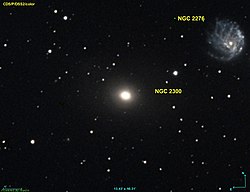
NGC 383 is a double radio galaxy with a quasar-like appearance located in the constellation Pisces. It is listed in Halton C. Arp's 1966 "The Arp Atlas of Peculiar Galaxies." Recent discoveries by the National Radio Astronomy Observatory in 2006 reveal that NGC 383 is being bisected by high energy relativistic jets traveling at relatively high fractions of the speed of light. The relativistic electrons in the jets are detected as synchrotron radiation in the x-ray and radio wavelengths. The focus of this intense energy is the galactic center of NGC 383. The relativistic electron jets detected as synchrotron radiation extend for several thousand parsecs and then appear to dissipate at the ends in the form of streamers or filaments.

NGC 935 and IC 1801 are a pair of interacting galaxies within the Aries constellation. They were discovered on 18 September 1885 by Lewis Swift. NGC 935 is the northern member of the pair, and IC 1801 is the southern. Together, they are listed in Halton Arp's Atlas of Peculiar Galaxies as Arp 276, as an example of interacting galaxies.
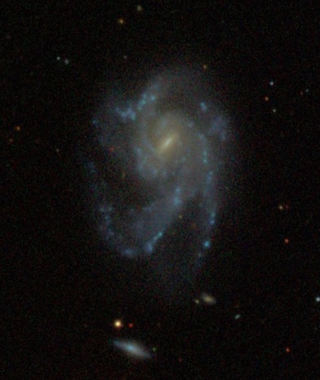
NGC 5579 is an intermediate spiral galaxy in the northern constellation of Boötes. It was discovered on May 1, 1785) by German-British astronomer William Herschel. The galaxy is located at a distance of 179 ± 14 million light-years (54.9 ± 4.3 Mpc) from the Milky Way, and is receding with a heliocentric radial velocity of 3,608 km/s. It is entry 69 in Halton Arp's Atlas of Peculiar Galaxies.
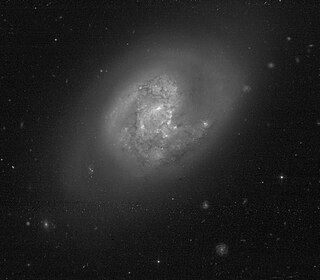
NGC 5665 is a spiral galaxy in the northern constellation of Boötes. It was discovered on January 30, 1784 by German-British astronomer William Herschel. This galaxy is located at a distance of 53.6 ± 7.7 million light-years (16.44 ± 2.37 Mpc), and is receding with a heliocentric radial velocity of 2,237 km/s. It is cataloged in Halton Arp's Atlas of Peculiar Galaxies as object number 49.
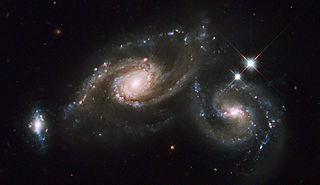
The NGC 5679 group, also known as Arp 274, is a triplet of galaxies, MCG+1-37-36, MCG+1-37-35 and MCG+1-37-34, spanning about 200000 light-years and at some 400 million light-years from Earth in the constellation Virgo. Arp 274 refers to the Atlas of Peculiar Galaxies, compiled by Halton Arp in 1966. Galaxies 269 through 274 in his catalogue are galaxies that appear to have connected arms.

Arp 273 is a pair of interacting galaxies, 300 million light years away in the constellation Andromeda. It was first described in the Atlas of Peculiar Galaxies, compiled by Halton Arp in 1966. The larger of the spiral galaxies, known as UGC 1810, is about five times more massive than the smaller galaxy. It has a disc that is tidally distorted into a rose-like shape by the gravitational pull of the companion galaxy below it, known as UGC 1813. The smaller galaxy shows distinct signs of active star formation at its nucleus, and "it is thought that the smaller galaxy has actually passed through the larger one."

NGC 5566 is a barred spiral galaxy in the constellation Virgo, which is approximately 66 million light years away from Earth. The galaxy is the biggest in the constellation Virgo, stretching nearly 150,000 light years in diameter. The galaxy NGC 5566 was discovered on 30 April 1786 by the German-British astronomer William Herschel. It is included in Halton Arp's Atlas of Peculiar Galaxies. It is a member of the NGC 5566 Group of galaxies, itself one of the Virgo III Groups strung out to the east of the Virgo Supercluster of galaxies.

Arp 7 is a spiral galaxy in the constellation Hydra. Redshift-independent measurements of its distance vary widely, from 5.9 Mpc to 83.7 Mpc. Its morphological classification is SB(rs)bc, meaning it is a barred spiral galaxy with some ring-like structure.

NGC 2857 is a spiral galaxy in the constellation Ursa Major. It was discovered on January 9, 1856, by R. J. Mitchell.

NGC 3800 is an intermediate spiral galaxy located in the constellation Leo. Its speed relative to the cosmic microwave background is 3,653 ± 24 km/s, which corresponds to a Hubble distance of 53.9 ± 3.8 Mpc. NGC 3800 was discovered by German-British astronomer William Herschel in 1784.

NGC 3799 is a barred spiral galaxy located in the constellation Leo. Its speed relative to the cosmic microwave background is 3,659 ± 24 km/s, which corresponds to a Hubble distance of 54.0 ± 3.8 Mpc. NGC 3799 was discovered by British astronomer John Herschel in 1832.
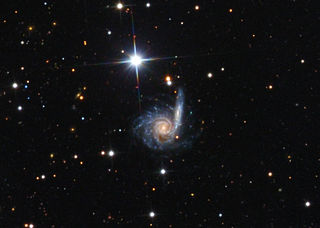
NGC 6365 is a pair of spiral galaxies in the constellation Draco. It consists of two galaxies, PGC 60174 to the south, and PGC 60171 to the north. These two galaxies are also designated respectively by the NASA/IPAC database as NGC 6365A and NGC 6365B. This pair of galaxies was discovered by German astronomer Lewis Swift in 1884.

NGC 3290 is a large and relatively distant intermediate spiral galaxy located in the constellation Hydra. Its speed relative to the cosmic microwave background is 10,937 ± 27 km/s, which corresponds to a Hubble distance of 161 ± 11 Mpc. NGC 3290 was discovered by American astronomer Francis Leavenworth in 1886.
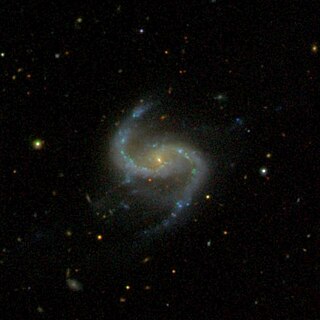
NGC 4017 is an intermediate spiral radio galaxy located in the constellation Coma Berenices. Its speed relative to the cosmic microwave background is 3,748 ± 21 km/s, which corresponds to a Hubble distance of 55.3 ± 3.9 Mpc. NGC 4017 was discovered by German-British astronomer William Herschel in 1785.

NGC 2648 is a spiral galaxy located in the constellation Cancer. Its speed relative to the cosmic microwave background is 2,451 ± 19 km/s, which corresponds to a Hubble distance of 36.2 ± 2.6 Mpc. NGC 2648 was discovered by German-British astronomer William Herschel in 1784.

NGC 2937 is an elliptical galaxy located in the constellation Hydra. Its velocity relative to the cosmic microwave background is 105.1 ± 7.4 km/s, which corresponds to a Hubble distance of 105.1 ± 7.4 Mpc. NGC 2937 was discovered by German astronomer Albert Marth in 1864.

NGC 7253 is a pair of spiral galaxies in the constellation Pegasus. It was discovered by the German-British astronomer Albert Marth on 9 September 1863. It is listed in Halton Arp's Atlas of Peculiar Galaxies as Arp 278, as an example of gravitationally interacting galaxies.

NGC 3187, also known as HGC 44D, is a large barred spiral galaxy located in the constellation Leo. Its velocity relative to the cosmic microwave background is 1,901 ± 22 km/s, which corresponds to a Hubble distance of 28.0 ± 2.0 Mpc. NGC 3187 was discovered by Irish physicist George Stoney in 1850.

NGC 5394 is a barred spiral galaxy located in the constellation Canes Venatici. Its speed relative to the cosmic microwave background is 3,639 ± 14 km/s, which corresponds to a Hubble distance of 53.7 ± 3.8 Mpc. NGC 5394 was discovered by German-British astronomer William Herschel in 1787.
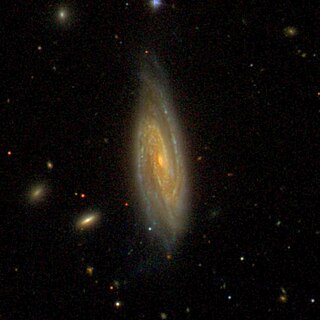
NGC 958 is a barred spiral galaxy in the constellation of Cetus. Its velocity with respect to the cosmic microwave background is 5505 ± 17 km/s, which corresponds to a Hubble distance of 81.20 ± 5.69 Mpc. However, 19 non-redshift measurements give a distance of 58.93 ± 12.91 Mpc. The galaxy was discovered by German-British astronomer William Herschel on 20 September 1784.
